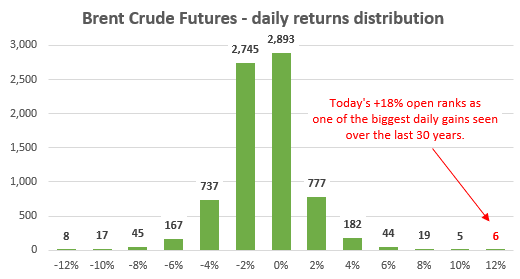*Global oil supply disrupted
*Source of drones uncertain
*Crude rallies, ASX helped by oil & gas stocks
What do we know?
A quiet weekend quickly became frenetic when news emerged of a
drone attack on major Saudi Arabian oil and gas infrastructure east of Riyadh at the Abqaiq processing facility and Khurais oil fields.
The Abqaiq facilities process up to 7% of daily global oil production while Khurais oil fields, Saudi Arabia's second largest oilzone, has an output of 1.5 million bpd. The Saudi ministry notes around 5.7 million bpd of capacity, equivalent to around
~5% of daily global oil supply,
was disrupted as a result of the premeditated 10 drone attack.
How long it takes for the supply deficit to be restored remains unclear. However, Saudi Arabia intends to restore around ~2-3mn bpd by close of Monday, with the rest of the shortage potentially bridged by Saudi oil inventories and US petroleum reserves. It's likely to take a few weeks before Saudi Arabia is fully back online.
.PNG.aspx)
Source: ThinkMarkets, estimates pulled from WSJ, Bloomberg, Thomsen Reuters
Who's behind it?
Who really knows.
The Yemeni Houthi Rebels originally came forward to claim ownership but The US were quick to poke holes in their story, directing blame on Iran. Apparently, the Drones weren't coming from the south (Yemen lies under Saudi Arabia) and instead were attacking from the north (direction of Iran). Kuwait went as far as to validate that drones were sighted in their airspace early Saturday morning.
Iran have vehemently denied their involvement, warning that they are "ready for war" with US bases dotted around the Middle East all within missile range. The attack comes at an interesting time when Rouhani, Iran's President, refuses to meet with Trump until sanctions are lifted. Suspiciously as well, Rouhani is due to sit down today to meet Putin and Erdogan in Ankara for a tri-nation summit. A photo of the three floating around strikingly resembles that of a villainous cabal.
Action in the Middle East these days is like a giant iceberg. What you see is not what you get.
I still think you can't rule out Russian involvement insofar as they benefit from higher oil prices as ~45% of their exports relate to crude and refined petroleum. And the same argument goes for The US and Saudi Arabia (especially Saudi Arabia), though I'd suspect The US to a lesser extent, given oil inflation also hurts alot of their domestic industries. But generally, I'd never rule it out. The US have been the genesis of a lot of Middle East's problems.
How did markets react?
With much anticipation leading into it, the entire crude complex shot up as expected.
Brent Crude Futures were +18% at the open but have since fallen back in early Asia. Looking at daily return data, Monday's aggression at the open ranks as one of the biggest returns for Brent Crude in the past 30 years.

Source: Thomson Reuters daily data, 1989-2019
Gasoline Futures +11% and
Heating Oil Futures +6.5% also made big gains at the open.
USDCAD gapped lower, as expected, with Canadian Dollar strengthening +0.5% on the back of higher oil prices. While
USDJPY gapped -0.4% as risk-off sentiment heightened.
In equities space,
S&P500 Futures opened 15pts lower and has since edged down another 7 pts.
The
ASX 200 currently trades around Friday's close having defied a lower open like other equity futures, led by an expected rally in Oil & Gas stocks -
Oilsearch (OSH.AX) +6.9%,
Woodside Petroleum (WPL.AX) +5% and
Santos (STX.AX) 3.9%.